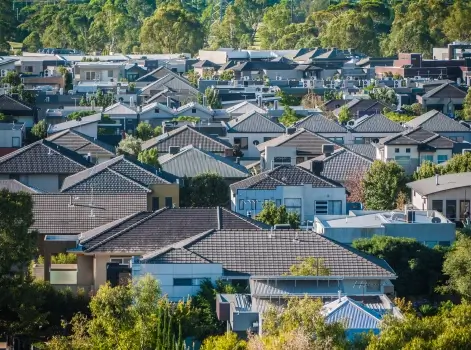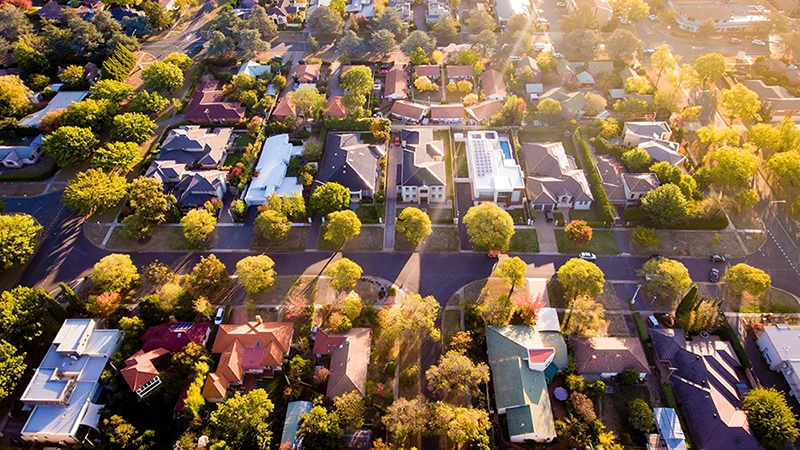Updated: 26 Dec, 2024
CoreLogic’s Home Value Index recorded a seventh straight month of decline in November 2022, falling 1%. Although values have continued to fall, the rate of decline has been moderating since it dropped by 1.6% in August.
Despite the decline, housing values surged 28.6% higher than the recent upswing, adding $170,700 to the average dwelling value.
CoreLogic research director Tim Lawless said the ease in the rate of decline was evident in Sydney, Melbourne and across many smaller capitals and regional markets.
“Three months ago, Sydney housing values were falling at the monthly rate of 2.3%. That has now reduced by a full percentage point, to a decline of 1.3% in November. In July, Melbourne home values were down 1.5% over the month, with the monthly decline almost halving last month, to 0.8%.
“The rate of decline has also eased across the ACT (from a 1.7% fall in August) and is no longer accelerating in Brisbane. Most of the broad rest-of-the-state markets have also seen the pace of declines decelerate.”
Sydney was the only city where housing values fell more than 10% from their peak. Through the downturn to date, values in the market have fallen 11.4%.
Why Are Declines Easing?
Lawless explained that people’s initial hesitation around buying property in a high-interest rate environment could be wearing off. Furthermore, the low advertised stock levels contributed to the smaller value falls.
However, he cautioned that the pace of declines could re-accelerate if the current rate hiking cycle persists for much longer.
Perth and Darwin have yet to record any signs of a major downturn. These cities have been insulated by a healthy level of housing affordability, tight labour markets and strong economic conditions.
Unit values experienced a lower rate of decline than house values – 0.6% compared to 1.2%. This could be because units are more affordable at a time when borrowing capacity has reduced.
Property Market Highlights
Here’s what happened to Australia’s housing market in November 2022:
- This year’s spring listing season was mild. Over the four weeks ending November 27, the flow of new capital city listings was 30.8% lower than in 2021 and 14.2% below the previous five-year average.
- The low number of listings was a key factor that offset the negative impact of higher interest rates and poor consumer sentiment.
- Demand for capital city homes was estimated to be 23.3% lower than in 2021 and 1.6% below the five-year average over the three months to November.
- Across Sydney, estimated home sales were down 38.6% compared with last year. Similarly, Melbourne’s home sales were down 33.8%, and Brisbane’s home sales were down 18.4% compared with last year.
- The rental market remained tight, as most regions held around 1% or lower vacancy rates. A combination of low rental supply and high rental demand due to a rebound in net overseas migration kept vacancy rates low.
- There is evidence that rental growth is easing in some cities. The quarterly trend in capital rental growth was reduced to 2.5% from its peak of 3.1% in July 2022.
- The softening of rental growth is more apparent for houses than units. Lawless explained that renters could be transitioning towards more affordable options. Furthermore, as tenancy costs rise, households could seek to maximise occupancy to spread higher rental costs across a larger number of tenants. The easing in demand for detached housing could be due to the completion of the backlog of housing construction projects.
- Gross rental yields across combined capitals rose to 3.5% in November. Across regional Australia, gross rental yields rose to 4.43%.
Housing Market Outlook
The housing market’s outlook hinges on the trajectory of interest rates.
Interest rates could peak in the first half of 2023. Lawless explains, “In December, we are likely to see the cash rate reach 3.1%, taking the cumulative increase to three percentage points. Importantly, this takes interest rates to the limit of mortgage serviceability assessments recent borrowers were tested on.”
- To date, mortgage arrears are low, but 90-day arrears could rise over time, given the higher interest rate settings and elevated inflation against a backdrop of record levels of housing indebtedness.
- Borrowers on fixed-rate mortgages could face higher mortgage distress when those terms end. The Reserve Bank of Australia noted that, historically, 20% of home loans have been on a fixed term. Now, around 35% of home loans are on a fixed term. Two-thirds of these loans will expire by 2023, and borrowers will face a 3-4 percentage point increase in their mortgage rate.
- The risk of default remains low, due to a low unemployment rate, strong household savings and homeowners making higher-than-required mortgage repayments. The RBA noted that as of August 2022, the median variable rate borrower had enough in their offset or redraw account to cover 20 months of mortgage repayments.
Some Hope For First-home Buyers
Persistently low inventory has helped balance the decline in housing demand. Advertised stock levels were well below the average, and there is no evidence of oversupply.
- Some housing affordability measures are easing, however, indicating lower entry barriers for first-home buyers.
- Across combined capitals, the median dwelling value to income ratio reduced from 8.4 in the March quarter to 7.9 in the September quarter.
- The estimated average number of years needed to save for a 20% deposit fell from 11.1 in March to 10.6 in September.
However, homebuyers should consider worsening serviceability costs. As interest rates rise, the portion of income required to service a new home loan could increase in 2023.










